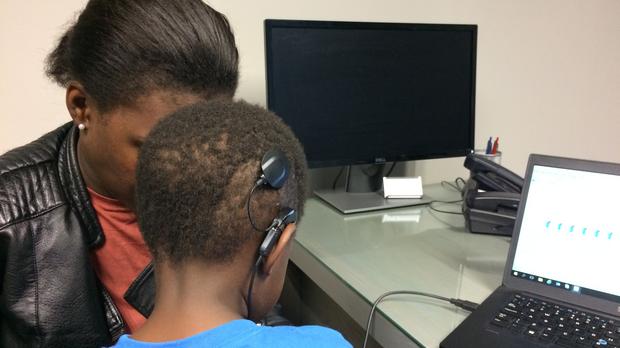Blog
-

How an implant helped a boy, 4, hear again with the first 3 Tesla MRI compatible implant in the Western Cape.
 8 May , 2018
8 May , 2018
How an implant helped a boy, 4, hear again with the first 3 Tesla MRI compatible implant in the Western Cape.
For two years Jose Macedo’s world has been very silent after he lost his hearing at the age of two, following a suspected infection.
This month the bubbly 4-year-old boy from Angola could hear sounds for the first time following his surgery that saw him getting a new high technology cochlear implant, known as MED-EL cochlear implant. He was the first patient to have this sophisticated device implanted in the Western Cape and at the Netcare Christiaan Barnard Memorial Hospital.
While implantable and magnetic hearing device have become a standard treatment for deafness in South Africa and other parts of the world, what makes MED-EL cochlear implant unique is its compatibility to the Magnetic Resonance Imaging (MRI) scan, which uses powerful magnets to create detailed images of the inside of a person’s body.
MRI safety is especially important for cochlear implant recipients, because every cochlear implant has an internal magnet that can be affected by an MRI scan. Often patients require surgery to remove the magnet first before they use an MRI.
Dr Louis Hofmeyr, an otologist, and neurotologist, who implanted the hearing device on Jose, said the MED EL implant was 3 Tesla MRI compatible – meaning that recipients could have the high resolution imaging without needing to surgically remove the magnet.
(“This is something not often discussed in articles relating to cochlear implants, and perhaps deserves a bit more explanation” . ~Maria Laycock, A Atlantic Hearing)
Tesla units refer to the strength of MRI machines and most cochlear implants can only withstand 1.5 Tesla, otherwise, the magnet has to be surgically removed before having an MRI scan, which is not a casual task.
Tesla (T) is the unit of measurement quantifying the strength of a magnetic field. Prior to the 3 Tesla Machine, the high-field standard was 1.5 Tesla. A “3 Tesla” scanner generates a magnetic field that is twice the strength of 1.5 Tesla machines and 10 to 15 times the strength of low field or open MRI scanners. The magnetic field produced by a 3 Tesla Machine MRI System yields exceptional anatomic detail. Thus, if a picture is worth a thousand words, the 3 Tesla MRI is an encyclopedia. The increased image clarity revealed by 3T is particularly beneficial for pathological conditions involving the brain, spine, and musculoskeletal system.
The benefits of the 3T scanner are not confined to Magnetic Resonance Imaging. The increased spatial resolution of the 3T scanner allows for high-quality vascular imaging. Thus, 3 Tesla MR Angiogram studies may often supplant the need for invasive interventional catheter studies.
The 3 Tesla Machine is extremely efficient. Utilizing shorter scan times, the 3T machine maximizes patient comfort without compromising quality. The superb reliability of high-field MRI allows board-certified radiologists to differentiate between benign and potentially hazardous medical conditions with confidence. This allows your health-care team to provide you with earlier diagnosis and treatment, subsequently leading to more positive outcomes.
Insurance companies pay the same amount for an MRI, regardless of whether your exam is performed on a low-field or high-field magnet machine.
Macedo’s implant was switched on last week, just a few weeks after he had surgery to insert the device.
His emotional mother, Martha, who traveled all the way from Angola to be with her son, was over the moon after seeing her son responding to sound for the first time in 2 years.
“As soon as they switched on the implant, the phone rang and he quickly turned to it. We all cried in the room with disbelief, he could really hear again. I was just overwhelmed with joy,” she said.
She recalled that Jose’s hearing problems started when he developed a cold that complicated. All the family thought it was a temporary problem and everything would go back to normal once he was on the mend, but his hearing was never restored.
“Suddenly his ears were blocked and he couldn’t hear me. He was saying Huh… What.. all the time, and most of the time he wouldn’t look at me when I talked to him. What brought me into a crisis mode was him not responding to a ringing phone and run to it like he usually did when growing up,” explained Martha.
To watch her child gradually losing his hearing and his speech was the most frustrating thing for her parents. Hofmeyer said he was quite happy that Jose could hear again. He advised parents to seek medical assistance the as soon as they picked up any hearing problems.
“Implanting a child with hearing loss should be done as young as possible in order for the child to develop speech. The older the person the poorer the outcome as there is a critical window period to develop speech and language. Therefore, the hearing screening, which can be performed within 24 hours of the child’s birth is also essential,” said Hofmeyr.
Macedo will need more follow ups to adjust the sound and the volume of the device as his hearing gradually improves.
Source: IOL, VIWE NDONGENI, 3timaging.com
Image credit: Supply, Jose Macedo





























































































































































































































































































































































































































































































































































































